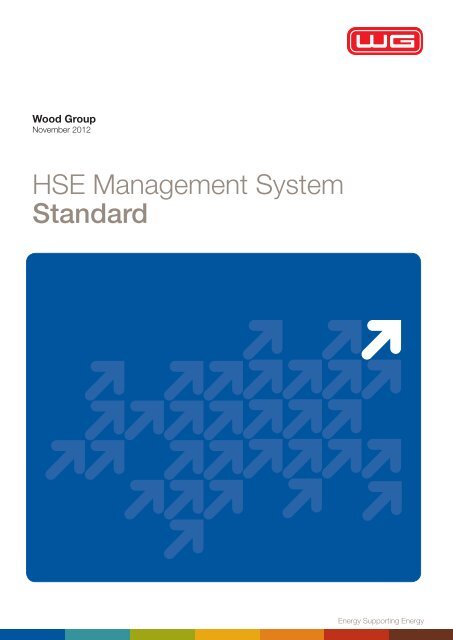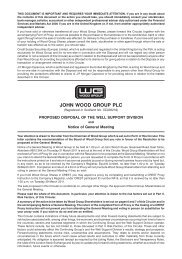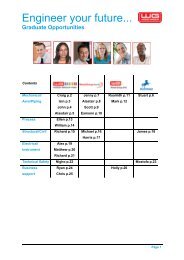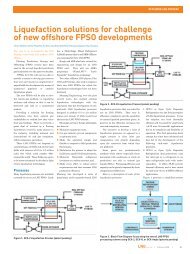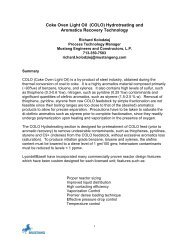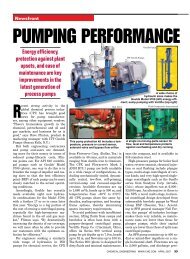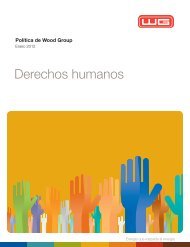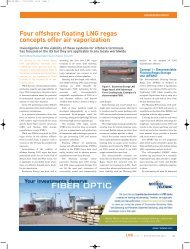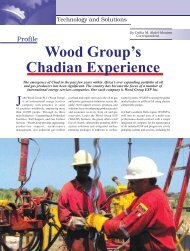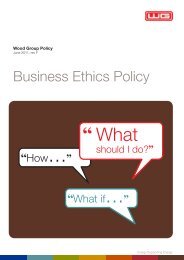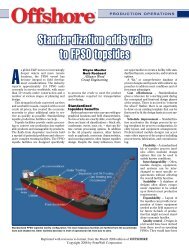HSE Management System Standard - Wood Group
HSE Management System Standard - Wood Group
HSE Management System Standard - Wood Group
Create successful ePaper yourself
Turn your PDF publications into a flip-book with our unique Google optimized e-Paper software.
<strong>Wood</strong> <strong>Group</strong><br />
November 2012<br />
<strong>HSE</strong> <strong>Management</strong> <strong>System</strong><br />
<strong>Standard</strong><br />
Energy Supporting Energy
<strong>Wood</strong> <strong>Group</strong> <strong>HSE</strong> <strong>Management</strong> <strong>System</strong> <strong>Standard</strong><br />
Contents<br />
Introduction 1<br />
Our core Values 2<br />
Scope 3<br />
The system structure 4<br />
<strong>Wood</strong> <strong>Group</strong> Health, Safety and Environmental policy 5<br />
Key elements 6<br />
How this book works 7<br />
01 Leadership 8<br />
02 Objective setting 10<br />
03 Organisation 12<br />
04 Legislative compliance 14<br />
05 Risk management 16<br />
06 Health and community 18<br />
07 Human factors 20<br />
08 Training and competence 22<br />
09 Information, documents and standards 24<br />
10 Integrity management 26<br />
11 Third parties and suppliers 28<br />
12 Emergency preparedness and response 30<br />
13 Environmental management 32<br />
14 Incident reporting and investigation 34<br />
15 Change management 36<br />
<strong>Wood</strong> <strong>Group</strong> SAF/B/1.2 November 2012
<strong>Wood</strong> <strong>Group</strong> <strong>HSE</strong> <strong>Management</strong> <strong>System</strong> <strong>Standard</strong><br />
Welcome to <strong>Wood</strong> <strong>Group</strong>’s<br />
Health, Safety and Environmental<br />
<strong>Management</strong> <strong>System</strong> <strong>Standard</strong>.<br />
<strong>Wood</strong> <strong>Group</strong> is an increasingly global business operating<br />
in over 50 countries. It is vital that we conduct all our<br />
operations, wherever they are, in a way that neither<br />
harms people nor the environment. We have moral,<br />
professional and legal obligations to deliver our services<br />
in ways that assure we protect people’s health,<br />
prevent incidents and injuries and minimise adverse<br />
environmental impact. Our commitment to that is clearly<br />
laid out in our <strong>HSE</strong> Policy Statement.<br />
We can only live up to that commitment if we organise<br />
ourselves in a planned, systematic way and that is why<br />
we have had a <strong>Wood</strong> <strong>Group</strong> <strong>HSE</strong> <strong>Management</strong> <strong>System</strong><br />
in place for many years. The regularly revised document<br />
describing the system has become familiarly known over<br />
the years as the ‘Red Book’.<br />
This latest revision for 2012 has been significantly<br />
updated to reflect current best practice and to fit within<br />
the context of our recently launched <strong>Group</strong> core Values.<br />
Sections on Leadership, Human Factors and Integrity<br />
<strong>Management</strong> have been highlighted as especially relevant<br />
updates and the core Values have been included as a<br />
reminder of what we are committed to as an integral part<br />
of doing business.<br />
We emphasise the Safety & Assurance core Value as<br />
our top priority, and as it is colour coded in blue, we<br />
anticipate that this new revision of the <strong>Standard</strong> will<br />
become known as the ‘Blue Book’.<br />
The ‘Blue Book’ contains sound advice for transforming<br />
our aspirations into practice and it is vital that Business<br />
and <strong>HSE</strong> leaders read, understand and apply it.<br />
Allister Langlands,<br />
Chairman<br />
SAF/B/1.2 November 2012 <strong>Wood</strong> <strong>Group</strong> 1
<strong>Wood</strong> <strong>Group</strong> <strong>HSE</strong> <strong>Management</strong> <strong>System</strong> <strong>Standard</strong><br />
Our core Values<br />
We’ll work in partnership<br />
with our clients, the<br />
regulators and our<br />
employees to deliver our <strong>HSE</strong><br />
objectives.<br />
Within this<br />
standard we set<br />
out the framework<br />
to protect the<br />
health of everyone<br />
that we work with<br />
and to sustain our<br />
operations free of<br />
incidents and injuries. An<br />
essential aspect of this<br />
is understanding human<br />
behaviour and assuring<br />
training and competence<br />
is appropriate to the<br />
risks encountered.<br />
<strong>HSE</strong> excellence is a sign<br />
of a successful business.<br />
We won’t compromise <strong>HSE</strong><br />
excellence for financial<br />
gain.<br />
2 <strong>Wood</strong> <strong>Group</strong> SAF/B/1.2 November 2012<br />
Within this <strong>Standard</strong>, you will see this<br />
expanded upon. It will variously use terms<br />
such as safety, assurance, security, quality<br />
and integrity. These are all valid and critical<br />
extensions of the Safety & Assurance core Value.<br />
Safety & Assurance<br />
Safety & assurance is our top priority. We<br />
passionately care about the safety of our<br />
people and behave as safety leaders. We are<br />
committed to preventing injuries and ill health<br />
to our people and everyone we work with.<br />
Relationships<br />
Our business depends on healthy relationships<br />
with customers, business partners and<br />
suppliers.<br />
Social Responsibility<br />
Being socially responsible is integral to what<br />
we do. We aim to make a positive difference to<br />
the communities where we operate and seek<br />
ways to assist them.<br />
People<br />
People are our business. We are professional,<br />
high performing team players focused on<br />
delivering and drawing on our global expertise.<br />
Innovation<br />
Innovation gives us competitive advantage.<br />
Financial Responsibility<br />
We expect to receive fair reward for our<br />
business performance. We are cost aware and<br />
carefully manage our own and our customers’<br />
costs.<br />
Integrity<br />
We are proud of our reputation, built over many<br />
years, which depends on us doing the right<br />
thing.<br />
We will be honest,<br />
fair and open in our<br />
management of <strong>HSE</strong>.<br />
Within this <strong>Standard</strong>,<br />
the main extension<br />
of this core Value<br />
is in the area of<br />
environmental care,<br />
where we define our<br />
obligations and<br />
aspirations to<br />
reducing resource<br />
consumption, waste<br />
and any negative<br />
impacts of what<br />
we do.<br />
We’ll use both<br />
traditional continuous<br />
improvement techniques,<br />
as well as embracing<br />
innovation, to deliver our<br />
<strong>HSE</strong> objectives.
<strong>Wood</strong> <strong>Group</strong> <strong>HSE</strong> <strong>Management</strong> <strong>System</strong> <strong>Standard</strong><br />
Scope<br />
This document defines <strong>Wood</strong> <strong>Group</strong> (the<br />
‘<strong>Group</strong>’) <strong>HSE</strong> standards and provides guidance<br />
on the development and implementation of<br />
<strong>HSE</strong> <strong>Management</strong> <strong>System</strong>s to ensure that<br />
every <strong>Group</strong> Business Unit worldwide operates<br />
in ways which:<br />
• assure people’s health<br />
• prevent incidents and injuries, and<br />
• minimise adverse environmental impact.<br />
This document applies wherever:<br />
• the <strong>Group</strong> manages Business Units, companies,<br />
contracts, projects etc<br />
• the <strong>Group</strong> owns the assets and employs or engages<br />
the relevant workers in its own right<br />
• the <strong>Group</strong> has a contractual obligation to owners of<br />
the entity or assets in question, or to other participants<br />
in the activity in question and has appropriate authority<br />
to conduct the activity<br />
• the <strong>Group</strong> has personnel on clients’ premises<br />
• a <strong>Group</strong> company is a ‘duty holder’, or holds similar<br />
status, in respect of applicable <strong>HSE</strong> legislation.<br />
This document provides a basis on which to manage <strong>HSE</strong><br />
in a Business Unit. It should be used:<br />
• by companies acquired by the <strong>Group</strong><br />
• as a credible foundation for status review<br />
• for new Business Unit start-ups<br />
• after major organisational change<br />
• after joint venture partnership establishment<br />
• during major contract or project mobilisations<br />
• as a baseline, against which existing or intended<br />
systems can be assessed, and any gaps identified<br />
and remedial action taken.<br />
International standards compliance: this document<br />
promotes and encourages compliance with the<br />
two accepted standards for Health & Safety and<br />
Environmental <strong>Management</strong>, specifically OHSAS 18001<br />
and ISO 14001.<br />
Legislative compliance: this document anticipates<br />
compliance with <strong>HSE</strong> legislative requirements applicable<br />
to each Business Unit.<br />
Business Unit: In the context of this document, this<br />
term means any company, operation, contract, project or<br />
product stream which is required to maintain its own <strong>HSE</strong><br />
management processes.<br />
SAF/B/1.2 November 2012 <strong>Wood</strong> <strong>Group</strong> 3
<strong>Wood</strong> <strong>Group</strong> <strong>HSE</strong> <strong>Management</strong> <strong>System</strong> <strong>Standard</strong><br />
The system structure<br />
<strong>Group</strong><br />
What Business Units are<br />
directed to do by <strong>Group</strong><br />
Procedures<br />
<strong>Group</strong><br />
<strong>HSE</strong> Policy<br />
<strong>Group</strong><br />
<strong>HSE</strong><br />
<strong>Management</strong><br />
<strong>System</strong><br />
<strong>Standard</strong><br />
<strong>Group</strong><br />
Annual<br />
<strong>HSE</strong><br />
Objectives<br />
Procedures<br />
Procedures<br />
<strong>Group</strong> Procedures and<br />
Guidelines<br />
Adopt, endorse<br />
or augment…<br />
Adopt or<br />
translate into …<br />
Recognise and<br />
develop…<br />
4 <strong>Wood</strong> <strong>Group</strong> SAF/B/1.2 November 2012<br />
Procedures<br />
Adopt or match with<br />
equivalents …<br />
Business Units’ <strong>HSE</strong> <strong>Management</strong> <strong>System</strong>s<br />
How Business Units translate <strong>Group</strong><br />
and external influences<br />
<strong>HSE</strong><br />
Policy<br />
Annual<br />
<strong>HSE</strong> Plan<br />
<strong>HSE</strong><br />
Sub-plans<br />
Supporting documents<br />
Supporting <strong>HSE</strong> organisation<br />
To ensure the effective connection of the <strong>Group</strong> <strong>HSE</strong> organisation with the Business Unit organisation, a Safety<br />
& Assurance Steering <strong>Group</strong> exists at Senior <strong>Management</strong> level, populated by both <strong>Group</strong> <strong>HSE</strong> Function<br />
<strong>Management</strong> and Business Unit Senior <strong>Management</strong>, which reports into the <strong>Group</strong> Board Executive.<br />
l<br />
Business Unit Operating Procedures<br />
Procedures<br />
Procedures<br />
Business Units will:<br />
• have an <strong>HSE</strong> <strong>Management</strong> <strong>System</strong><br />
• adopt the <strong>Group</strong> <strong>HSE</strong> Policy, which will be<br />
reflected in the <strong>HSE</strong> <strong>Management</strong> <strong>System</strong><br />
• set annual Business Unit-wide <strong>HSE</strong> objectives,<br />
and establish plans to attain them<br />
• have contract or product sub-plans, where this<br />
is appropriate<br />
• have supporting documents and guidelines to<br />
make the process complete and coherent<br />
• have suitable and sufficient procedures, from<br />
the <strong>Group</strong>, or locally developed, as appropriate.<br />
Procedures<br />
<strong>HSE</strong><br />
<strong>Management</strong><br />
<strong>System</strong><br />
Procedures<br />
Markets/Clients/<br />
Regulators<br />
The various external<br />
influences on Business<br />
Unit <strong>HSE</strong> <strong>Management</strong><br />
Expectations<br />
Specific issues<br />
Contractual conditions<br />
Compliance obligations
<strong>Wood</strong> <strong>Group</strong> <strong>HSE</strong> <strong>Management</strong> <strong>System</strong> <strong>Standard</strong><br />
<strong>Wood</strong> <strong>Group</strong><br />
Health, Safety and Environmental policy<br />
<strong>Wood</strong> <strong>Group</strong> is committed to delivering the highest standards<br />
of health, safety and environmental performance. This policy<br />
statement defines our commitments to our employees,<br />
clients, partners and shareholders.<br />
We will deliver our operations and services in ways to:<br />
• Protect the health of all people impacted by<br />
the work that we do<br />
• Prevent incidents and injuries, with a focus on<br />
integrity and the control of major hazards<br />
• Minimise adverse environmental impact, use resources<br />
efficiently and manage our carbon footprint<br />
We will achieve this by ensuring:<br />
• Leaders at all levels place health, safety and environment<br />
at the top of their agenda<br />
• Risks are identified, mitigated and controlled<br />
• Clear objectives are established and we measure our<br />
performance against them<br />
• We understand legislative and industry requirements, and<br />
ensure we comply with them<br />
• Those who work with us meet our standards<br />
• Our communications on health, safety and environment are<br />
transparent and inclusive<br />
We will regularly monitor the application of these<br />
commitments to provide assurance that we are delivering<br />
continuous improvement.<br />
Allister Langlands,<br />
Chairman<br />
SAF/B/1.2 November 2012 <strong>Wood</strong> <strong>Group</strong> 5
<strong>Wood</strong> <strong>Group</strong> <strong>HSE</strong> <strong>Management</strong> <strong>System</strong> <strong>Standard</strong><br />
Key elements<br />
This document defines 15 key elements which the<br />
<strong>Group</strong> deems to be central to the establishment and<br />
deployment of an effective <strong>HSE</strong> <strong>Management</strong> <strong>System</strong>.<br />
The existence of controls in these key areas is not<br />
enough in itself. Leaders must enforce these controls.<br />
Leadership is a key element in ensuring that this<br />
document delivers its aims.<br />
The elements set out in this document will be adopted by<br />
each Business Unit and assessed to ensure effective and<br />
efficient application and compliance.<br />
Compliance with this <strong>HSE</strong> <strong>Management</strong> <strong>System</strong><br />
<strong>Standard</strong> will be formally and periodically assessed by<br />
the <strong>Group</strong>. Learnings will be communicated both to the<br />
Business Unit concerned and to all Business Units who<br />
might benefit.<br />
Key Elements The following 15 elements give guidance,<br />
as well as providing minimum standards in formulating an<br />
<strong>HSE</strong> <strong>Management</strong> <strong>System</strong> appropriate to each Business<br />
Unit. Certain situations will demand much more and only<br />
by exception, will any require less.<br />
6 <strong>Wood</strong> <strong>Group</strong> SAF/B/1.2 November 2012<br />
01 Leadership<br />
02 Objective setting<br />
03 Organisation<br />
04 Legislative compliance<br />
05 Risk management<br />
06 Health and community<br />
07 Human factors<br />
08 Training and competence<br />
09 Information, documents<br />
and standards<br />
10 Integrity management<br />
11 Third parties and suppliers<br />
12 Emergency preparedness<br />
and response<br />
13 Environmental management<br />
14 Incident reporting<br />
and investigation<br />
15 Change management
<strong>Wood</strong> <strong>Group</strong> <strong>HSE</strong> <strong>Management</strong> <strong>System</strong> <strong>Standard</strong><br />
How this book works<br />
The 15 key elements which comprise the rest of<br />
this document are laid out to reflect the leadership<br />
responsibilities of those who can shape behaviours and<br />
culture (‘How we manage’) allied with the system design,<br />
deployment and compliance aspects of each of the<br />
elements (‘What we manage’). These two facing pages,<br />
when combined, reflect the principles of ‘Plan, Do,<br />
Check, Act’, with the leadership component focusing on<br />
Planning for success, Checking application and Acting<br />
on feedback, and the <strong>HSE</strong> professionals supporting this<br />
by Doing the appropriate system work, to the necessary<br />
extent.<br />
‘How we manage’<br />
The ‘How’ component, set out on each left-hand facing<br />
page, focuses on leadership, obligation to support,<br />
plan and resource, personal accountabilities and<br />
responsibilities of leaders. This is the ‘Plan, Check, Act’<br />
part of the process.<br />
Example page<br />
<strong>Wood</strong> <strong>Group</strong> <strong>HSE</strong> <strong>Management</strong> <strong>System</strong> <strong>Standard</strong> <strong>Wood</strong> <strong>Group</strong> <strong>HSE</strong> <strong>Management</strong> <strong>System</strong> <strong>Standard</strong><br />
01<br />
Leadership<br />
Leaders shape an organisation’s <strong>HSE</strong> culture and ultimately its<br />
<strong>HSE</strong> performance. Leaders will ensure that mechanisms are in<br />
place to manage <strong>HSE</strong> in their Business Units. Leaders within<br />
the <strong>Group</strong> will exhibit appropriate and positive personal <strong>HSE</strong><br />
behaviours.<br />
Leadership accountability<br />
• Demonstrate continual and constant<br />
awareness of <strong>HSE</strong> performance.<br />
• Ensure that people know they can raise <strong>HSE</strong><br />
concerns freely and without fear of negative<br />
consequences for themselves.<br />
• Allocate an adequate level of resources to<br />
implement <strong>HSE</strong> programmes effectively.<br />
• Understand the differences between personal,<br />
technical and process safety. Recognise that<br />
these need to be managed separately and<br />
have the necessary systems in place to ensure<br />
that they are.<br />
shape<br />
commitment<br />
8 <strong>Wood</strong> <strong>Group</strong> SAF/B/1.1 January 2012<br />
‘What we manage’<br />
The ‘What’ component, set out on each right-hand<br />
facing page, focuses on the essential minimum steps<br />
and considerations for each element, and relates to the<br />
specific area being managed. This is the ‘Do’ part of the<br />
process.<br />
Requirements<br />
• Control systems Institute and promote appropriate Business<br />
Unit-wide systems to support <strong>HSE</strong> objectives. Enforce and role<br />
model adherence to these systems.<br />
• Leadership commitment Demonstrate visible, personal<br />
commitment to all levels of the workforce ensuring that <strong>HSE</strong> is<br />
seen as a key priority for all WG employees.<br />
• Safety behaviours Ensure that correct and appropriate safety<br />
behaviours are encouraged and displayed within the Business<br />
Unit.<br />
• Continuous improvement Continuously seek ways to improve<br />
<strong>HSE</strong> performance. Identify lessons which can be learned, from<br />
whatever source, and use or share these with others.<br />
• Speak up-listen up Encourage and facilitate the delivery<br />
of both good and bad news. Invite, encourage and listen to<br />
feedback on leaders’ own safety performance and behaviours.<br />
• Challenge Don’t accept what’s assumed to be correct but isn’t<br />
supported by fact. Only base actions on verifiable information.<br />
• Diversity and inclusion Strive to understand the impact of<br />
different cultures and environments. Seek to include those with<br />
different perspectives and recognise how these variables can<br />
impact on <strong>HSE</strong> performance.<br />
• Resources Give the appropriate level of resource to<br />
<strong>HSE</strong> programmes.<br />
Assurance and verification<br />
• Ensure that there are records of leaders’ periodic <strong>HSE</strong> visits<br />
or conversations, such as promoted by the ‘Advanced Safety<br />
Conversations’ process.<br />
• Leaders’ steps to promote, manage and measure effective<br />
safety leadership must be recorded and verifiable.<br />
• <strong>HSE</strong> Programme implementation must be both evident and<br />
verifiable.<br />
Support<br />
Resources<br />
& References<br />
<strong>Group</strong> <strong>HSE</strong> Policy<br />
<strong>Group</strong> Safety Behavioural <strong>Standard</strong><br />
<strong>Group</strong> Safety Leadership Programme<br />
Core Values; Safety & Assurance<br />
Where to find this:<br />
www.woodgroup.net/<strong>HSE</strong><br />
SAF/B/1.1 January 2012 <strong>Wood</strong> <strong>Group</strong> 9<br />
SAF/B/1.2 November 2012 <strong>Wood</strong> <strong>Group</strong> 7
<strong>Wood</strong> <strong>Group</strong> <strong>HSE</strong> <strong>Management</strong> <strong>System</strong> <strong>Standard</strong><br />
01<br />
Leadership<br />
Leaders shape an organisation’s <strong>HSE</strong> culture and ultimately its<br />
<strong>HSE</strong> performance. Leaders will ensure that mechanisms are in<br />
place to manage <strong>HSE</strong> in their Business Units. Leaders within<br />
the <strong>Group</strong> will exhibit appropriate and positive personal <strong>HSE</strong><br />
behaviours.<br />
Leadership accountability<br />
• Demonstrate continual and constant<br />
awareness of <strong>HSE</strong> performance.<br />
• Ensure that people know they can raise <strong>HSE</strong><br />
concerns freely and without fear of negative<br />
consequences for themselves.<br />
• Allocate an adequate level of resources to<br />
implement <strong>HSE</strong> programmes effectively.<br />
• Understand the differences between personal,<br />
technical and process safety. Recognise that<br />
these need to be managed separately and<br />
have the necessary systems in place to ensure<br />
that they are.<br />
shape<br />
commitment<br />
8 <strong>Wood</strong> <strong>Group</strong> SAF/B/1.2 November 2012
<strong>Wood</strong> <strong>Group</strong> <strong>HSE</strong> <strong>Management</strong> <strong>System</strong> <strong>Standard</strong><br />
Requirements<br />
• Control systems Institute and promote appropriate Business<br />
Unit-wide systems to support <strong>HSE</strong> objectives. Enforce and role<br />
model adherence to these systems.<br />
• Leadership commitment Demonstrate visible, personal<br />
commitment to all levels of the workforce ensuring that <strong>HSE</strong> is<br />
seen as a key priority for all WG employees.<br />
• Safety behaviours Ensure that correct and appropriate safety<br />
behaviours are encouraged and displayed within the Business<br />
Unit.<br />
• Continuous improvement Continuously seek ways to improve<br />
<strong>HSE</strong> performance. Identify lessons which can be learned, from<br />
whatever source, and use or share these with others.<br />
• Speak up-listen up Encourage and facilitate the delivery<br />
of both good and bad news. Invite, encourage and listen to<br />
feedback on leaders’ own safety performance and behaviours.<br />
• Challenge Don’t accept what’s assumed to be correct but isn’t<br />
supported by fact. Only base actions on verifiable information.<br />
• Diversity and inclusion Strive to understand the impact of<br />
different cultures and environments. Seek to include those with<br />
different perspectives and recognise how these variables can<br />
impact on <strong>HSE</strong> performance.<br />
• Resources Give the appropriate level of resource to<br />
<strong>HSE</strong> programmes.<br />
Assurance and verification<br />
• Ensure that there are records of leaders’ periodic <strong>HSE</strong> visits<br />
or conversations, such as promoted by the ‘Advanced Safety<br />
Conversations’ process.<br />
• Leaders’ steps to promote, manage and measure effective<br />
safety leadership must be recorded and verifiable.<br />
• <strong>HSE</strong> Programme implementation must be both evident and<br />
verifiable.<br />
Support<br />
Resources<br />
& References<br />
<strong>Group</strong> <strong>HSE</strong> Policy<br />
<strong>Group</strong> Safety Behavioural <strong>Standard</strong><br />
<strong>Group</strong> Safety Leadership Programme<br />
Core Values; Safety & Assurance<br />
Where to find this:<br />
www.woodgroup.net/<strong>HSE</strong><br />
SAF/B/1.2 November 2012 <strong>Wood</strong> <strong>Group</strong> 9
<strong>Wood</strong> <strong>Group</strong> <strong>HSE</strong> <strong>Management</strong> <strong>System</strong> <strong>Standard</strong><br />
02<br />
Objective setting<br />
Business Units will be aware of, and comply with, all <strong>Group</strong> <strong>HSE</strong><br />
direction setting, including policy, objectives, plans, procedures<br />
and guidance documents. These shall be recognised and applied<br />
by each Business Unit, and supplemented by their own local<br />
policies, objectives, plans or client requirements as appropriate.<br />
Leadership accountability<br />
• Demonstrate compliance with the <strong>Group</strong><br />
<strong>HSE</strong> Policy and ensure it is visibly displayed<br />
in all Business Unit premises with evidence of<br />
effective local promotion and application.<br />
• Ensure actions to look at how policies and plans<br />
are deployed and effectively implemented within<br />
the Business Unit.<br />
• Show personal participation in <strong>HSE</strong> activities.<br />
direction<br />
intent<br />
focus<br />
10 <strong>Wood</strong> <strong>Group</strong> SAF/B/1.2 November 2012
<strong>Wood</strong> <strong>Group</strong> <strong>HSE</strong> <strong>Management</strong> <strong>System</strong> <strong>Standard</strong><br />
Requirements<br />
• <strong>Group</strong> <strong>HSE</strong> objectives Business Units will demonstrate<br />
awareness and adoption of <strong>Group</strong> <strong>HSE</strong> policies and objectives.<br />
• Local <strong>HSE</strong> objectives and annual plans Business Units<br />
will, if necessary, develop their own policies, objectives, plans,<br />
targets or other high-level declarations of <strong>HSE</strong> intent. These will<br />
be based upon and enhance <strong>Group</strong> requirements and/or reflect<br />
client and contract requirements.<br />
• Maintain key documents Business Unit documents shall<br />
show evidence of periodic checks to assure currency, suitability<br />
and value-adding. <strong>Management</strong> review is a means to achieve<br />
this.<br />
• Sustained focus Business Units should be rigorous in ensuring<br />
that a clear focus remains on safety-critical issues. We should<br />
not look to short-term solutions which may not be robust in the<br />
longer term. Quarterly reviews of objectives and plans should be<br />
considered. Annual formal reviews are expected.<br />
• Communication Business Unit and <strong>HSE</strong> leaders will promote<br />
these high level documents personally and communicate these<br />
to all levels of the business.<br />
• Personal objectives These will contain suitable <strong>HSE</strong><br />
objectives to support delivery of overall <strong>Group</strong> and Business<br />
Unit objectives.<br />
Assurance and verification<br />
• Business Unit reporting will routinely indicate progress to both<br />
<strong>Group</strong> and local <strong>HSE</strong> objectives and plans.<br />
• Business Units will effect formal periodic reviews (or<br />
revalidations) of their <strong>HSE</strong> plans, objectives or other key<br />
documents.<br />
Support<br />
Resources<br />
& References<br />
<strong>Group</strong> <strong>HSE</strong> Policy<br />
<strong>Group</strong> Policies<br />
<strong>Group</strong> Annual <strong>HSE</strong> Objectives<br />
Where to find this:<br />
www.woodgroup.net/<strong>HSE</strong><br />
www.woodgroup.net/policies<br />
SAF/B/1.2 November 2012 <strong>Wood</strong> <strong>Group</strong> 11
<strong>Wood</strong> <strong>Group</strong> <strong>HSE</strong> <strong>Management</strong> <strong>System</strong> <strong>Standard</strong><br />
03<br />
Organisation<br />
The organisation created to manage and assure <strong>HSE</strong> delivery<br />
must be clear, defined and understood. Responsibility may be<br />
delegated to a nominated person, but accountability cannot; that<br />
will always remain with the Business Unit leadership.<br />
Leadership accountability<br />
• Ensure that the organisation of the Business Unit<br />
with regard to Health, Safety and Environmental<br />
management is defined, clear and understood.<br />
• The <strong>HSE</strong> performance of the Business Unit is<br />
the primary accountability of the Business Unit<br />
leadership.<br />
• People emulate the behaviours of leaders.<br />
Business Unit leaders must recognise this<br />
when establishing their <strong>HSE</strong> organisation and<br />
ensure that leadership behaviour is a facet<br />
of organisational design.<br />
defined<br />
accountability<br />
12 <strong>Wood</strong> <strong>Group</strong> SAF/B/1.2 November 2012
<strong>Wood</strong> <strong>Group</strong> <strong>HSE</strong> <strong>Management</strong> <strong>System</strong> <strong>Standard</strong><br />
Requirements<br />
• Accountability Everyone in the Business Unit must be clear<br />
that they variously carry certain moral and legal responsibilities<br />
and accountabilities for <strong>HSE</strong>. Accountability cannot be shared<br />
or delegated.<br />
• Responsibility Responsibility can be shared or delegated.<br />
If this is the case, then this should be formal and clear.<br />
• Competence The competence of individuals discharging roles<br />
within the Business Unit and its <strong>HSE</strong> organisation must be clear<br />
and appropriate for the task (ref. Key Element 8).<br />
• Awareness People must be made aware of their <strong>HSE</strong><br />
responsibilities, preferably by more than one method.<br />
• Partnerships and joint ventures The impact on the Business<br />
Unit of this form of relationship will be formally assessed.<br />
Interfaces will be defined where necessary. There may be<br />
both internal and external interfaces to consider. Any case of<br />
applicable standards prevailing which are less stringent than<br />
those defined here will be made known to <strong>Group</strong> <strong>HSE</strong>.<br />
• <strong>Management</strong> of change Change can have unintended<br />
consequence. The impact of all change, including<br />
organisational change, must be formally assessed and<br />
managed (ref. Key Element 15).<br />
Assurance and verification<br />
• Leader, employee and contractor <strong>HSE</strong> responsibilities<br />
and accountabilities will be clear.<br />
• <strong>HSE</strong> organisation will be defined.<br />
• <strong>HSE</strong> competence will be assessed and managed.<br />
• <strong>HSE</strong> will be included in annual appraisal processes.<br />
Support<br />
Resources<br />
& References<br />
<strong>Group</strong> HR Guidance documents<br />
Where to find this:<br />
www.woodgroup.net/HR<br />
SAF/B/1.2 November 2012 <strong>Wood</strong> <strong>Group</strong> 13
<strong>Wood</strong> <strong>Group</strong> <strong>HSE</strong> <strong>Management</strong> <strong>System</strong> <strong>Standard</strong><br />
04<br />
Legislative compliance<br />
Business Units are subject to a wide range of compliance<br />
obligations embedded in local, regional, national and international<br />
legislative requirements.<br />
Business Units must develop and implement a systematic<br />
approach to identifying and demonstrating compliance with all<br />
applicable legislative requirements.<br />
Leadership accountability<br />
• Ensure that a legislative compliance system is<br />
developed and implemented.<br />
• Monitor compliance with the legislative<br />
requirements, address shortfalls and implement<br />
updated controls.<br />
obligation<br />
verify<br />
14 <strong>Wood</strong> <strong>Group</strong> SAF/B/1.2 November 2012
<strong>Wood</strong> <strong>Group</strong> <strong>HSE</strong> <strong>Management</strong> <strong>System</strong> <strong>Standard</strong><br />
Requirements<br />
• Legislative obligation Each Business Unit will identify all<br />
applicable <strong>HSE</strong> legal requirements affecting its business.<br />
A Register of applicable legislative requirements will be<br />
maintained.<br />
• Legislative compliance Each Business Unit will develop<br />
a systematic approach which assesses compliance with all<br />
applicable <strong>HSE</strong> legal requirements.<br />
• Nominated individual Each Business Unit will ensure that<br />
there is a nominated person responsible for tracking and<br />
monitoring all <strong>HSE</strong> legal requirements.<br />
• Compliance and gap analysis Business Units must possess<br />
a full awareness of applicable legislative requirements and<br />
be able to demonstrate compliance. This process will be<br />
maintained as current. Any known failure to comply shall be<br />
communicated to <strong>Group</strong> <strong>HSE</strong> and <strong>Group</strong> Legal.<br />
• Accessibility Documentation should be readily available and<br />
accessible where it is required.<br />
• Records management Records must be maintained to verify<br />
compliance and ensure the periodic execution of legislative<br />
compliance reviews or audits.<br />
Assurance and verification<br />
• Compliance monitoring Each Business Unit will conduct<br />
periodic reviews or audits to assess compliance. Findings<br />
identified in periodic reviews/audits must be tracked and<br />
monitored to ensure closure.<br />
• Compliance reporting Any non-compliance must be reported<br />
to the Business Unit leadership, <strong>Group</strong> <strong>HSE</strong>, <strong>Group</strong> Legal and,<br />
where required, to external regulatory bodies (subsequent to<br />
consultation with <strong>Group</strong> Legal). Review/audit reports will form<br />
part of the record of this.<br />
Support<br />
Resources<br />
& References<br />
Applicable <strong>HSE</strong> legislative<br />
requirements<br />
Where to find this:<br />
Regulations, standards etc.<br />
from authoritative sources<br />
www.woodgroup.net/legal<br />
SAF/B/1.2 November 2012 <strong>Wood</strong> <strong>Group</strong> 15
<strong>Wood</strong> <strong>Group</strong> <strong>HSE</strong> <strong>Management</strong> <strong>System</strong> <strong>Standard</strong><br />
05<br />
Risk management<br />
Business Units will establish processes to formally identify<br />
and understand hazards, and assess the <strong>HSE</strong> risks involved<br />
in all aspects of their business. These will be managed until<br />
they are eliminated, reduced or controlled to the point of being<br />
acceptable.<br />
Leadership accountability<br />
• Ensure hazards are clearly identified, and risks<br />
assessed and reviewed.<br />
• Appreciate and understand the key risks<br />
to the safe execution of their business and<br />
periodically assure themselves that these risks<br />
are appropriately managed and mitigated.<br />
• Maintain currency of process and identify and<br />
monitor changes which can introduce new risks.<br />
16 <strong>Wood</strong> <strong>Group</strong> SAF/B/1.2 November 2012<br />
identify,<br />
prevent,<br />
control<br />
and mitigate
<strong>Wood</strong> <strong>Group</strong> <strong>HSE</strong> <strong>Management</strong> <strong>System</strong> <strong>Standard</strong><br />
Requirements<br />
• Risk assessment A formal hazard identification/risk<br />
assessment process will exist. It will be appropriate to the<br />
severity of hazard liable to be encountered by the business.<br />
All potential hazard/risk elements will be considered, including<br />
the task itself, work environment, skill and competence, third<br />
parties, Business Unit, behaviour, human factors, emergencies<br />
and change management, as well as legal and regulatory<br />
obligations.<br />
• Risk techniques Consideration should be given to the use<br />
of standardised and structured processes in risk assessment,<br />
such as the use of Risk Matrices, Residual Risk Calculations<br />
and Statistical Analyses.<br />
• Risk scope The process must consider risk of harm to<br />
employees and third parties, environmental risk, business risk<br />
and reputational risk.<br />
• Risk mitigation Approved recommendations/controls will be<br />
acted upon. Risks should be eliminated, substituted (by using<br />
a less hazardous method), reduced or controlled, exposure<br />
limited and people protected and/or warned.<br />
• Residual risk Identified hazards will be managed such that<br />
the residual risk, if this cannot be eliminated entirely, will be<br />
managed so as to become as low as reasonably practicable.<br />
• Training and competency Risks will be assessed by<br />
competent people (ref Key Element 8).<br />
• <strong>Management</strong> of change Identify organisational, technical<br />
and legal changes which can introduce new risks to the<br />
Business Unit.<br />
Assurance and verification<br />
• Records of Risk Assessment will exist.<br />
• Risk mitigation, compliance and effectiveness will be formally<br />
determined and the extent of compliance known.<br />
• Periodic audits will be conducted to demonstrate compliance.<br />
• Appropriate documentation to verify compliance with applicable<br />
legislative requirements or standards will exist.<br />
Support<br />
Resources<br />
& References<br />
Industry, Regulatory or Market Sector<br />
Risk <strong>Management</strong> Guidance<br />
Where to find this:<br />
Guidance and publications from<br />
appropriate institutes, regulators and<br />
recognised bodies<br />
SAF/B/1.2 November 2012 <strong>Wood</strong> <strong>Group</strong> 17
<strong>Wood</strong> <strong>Group</strong> <strong>HSE</strong> <strong>Management</strong> <strong>System</strong> <strong>Standard</strong><br />
06<br />
Health and community<br />
The managed and planned care for the health of our people<br />
is critical, as is the avoidance of harm to the communities in<br />
which we work. We must operate in a way which ensures this is<br />
achieved.<br />
Leadership accountability<br />
• Ensure that both <strong>HSE</strong> and Human Resources<br />
management processes give due and formal<br />
regard to the protection of people from harm<br />
resulting from the work that they do. Care<br />
appropriately for them if these controls fail.<br />
• Ensure that any processes and activities which<br />
can harm the health of our people or have<br />
an impact on communities are formally risk<br />
assessed, eliminated, reduced or the potential<br />
for harm mitigated. This will be done in a formal<br />
and structured manner.<br />
protection<br />
awareness<br />
18 <strong>Wood</strong> <strong>Group</strong> SAF/B/1.2 November 2012
<strong>Wood</strong> <strong>Group</strong> <strong>HSE</strong> <strong>Management</strong> <strong>System</strong> <strong>Standard</strong><br />
Requirements<br />
• Health risk awareness Business Units must be aware of<br />
any health hazards they may encounter. Employees should be<br />
informed and made fully aware of any inherent health risks, as<br />
well as the necessary protection and/or mitigation processes for<br />
any task which they undertake.<br />
• Health assessment People joining a Business Unit will<br />
be assessed with regard to their capabilities and potential<br />
exposures, such as to eliminate or minimise any potential harm<br />
to their health.<br />
• Health protection Business Units will protect employees from<br />
the effects of any processes they may work with or encounter.<br />
Typically, this will include elimination, protection or control<br />
of issues such as hazardous substances, noise, vibration,<br />
radiation, stress or poor ergonomics.<br />
• Health surveillance A Health Surveillance Programme,<br />
appropriate to the hazards and risks encountered, will be<br />
implemented to detect any resultant ill health at an early stage<br />
and to safeguard the health of the employee.<br />
• Communities and third parties Business Units will provide<br />
appropriate care for anyone negatively affected by our activities.<br />
This principle extends to non <strong>Group</strong> or Business Unit people<br />
negatively impacted by what we do.<br />
Assurance and verification<br />
• Formal review of all cases of injury or harm to health versus<br />
controls and mitigations.<br />
• Periodic review to ensure that controls and mitigations remain<br />
current and effective.<br />
• Compliance with applicable local and national legislative<br />
requirements in this regard.<br />
Support<br />
Resources<br />
& References<br />
<strong>Group</strong> Policies and Procedures<br />
<strong>Group</strong> HR Guidance documents<br />
Prevailing local and national health<br />
protection legislative requirements<br />
Where to find this:<br />
Regulation, standards etc, from<br />
authoritative sources<br />
www.woodgroup.net/Policies<br />
www.woodgroup.net/HR<br />
SAF/B/1.2 November 2012 <strong>Wood</strong> <strong>Group</strong> 19
<strong>Wood</strong> <strong>Group</strong> <strong>HSE</strong> <strong>Management</strong> <strong>System</strong> <strong>Standard</strong><br />
07<br />
Human factors<br />
Business Units will consider and understand the role of Human<br />
Factors (HF) in initiating and mitigating incidents. All aspects of<br />
human behaviour, intentional and unintentional, organisational<br />
and personal, should be considered to help reduce the likelihood<br />
and consequences of serious incidents.<br />
HF include leadership, managing human failures, staffing,<br />
fatigue and shift work, safety critical communication, design,<br />
procedures, competence, organisational change and culture.<br />
Leadership accountability<br />
• Lead, support and actively participate in<br />
HF management programmes.<br />
• Ensure sufficient and appropriate resources are<br />
made available to address HF within the business.<br />
• Identify ‘Safety Critical Tasks’ and how they may be<br />
negated by HF, to help identify, prevent, control and<br />
mitigate Major Accident Hazards.<br />
• Develop improvement goals and associated<br />
metrics to monitor and measure the<br />
implementation and impact of HF management<br />
programmes. support<br />
care<br />
20 <strong>Wood</strong> <strong>Group</strong> SAF/B/1.2 November 2012
<strong>Wood</strong> <strong>Group</strong> <strong>HSE</strong> <strong>Management</strong> <strong>System</strong> <strong>Standard</strong><br />
Requirements<br />
• Planning A programme will be implemented to assess<br />
the potential impact of HF in all aspects of the workscope.<br />
Resources will be deployed to areas of maximum benefit.<br />
• Safety culture Perform gap analysis to identify areas for<br />
improvement. Monitoring of feedback will support the success<br />
of wider HF programmes.<br />
• Objectives and plans Monitoring and measurement<br />
processes will be used to evaluate the attainment of the HF<br />
programme plans and objectives.<br />
• Incident investigation Investigations of incidents must contain<br />
an element of HF analysis to identify if a human failure has<br />
occurred and, if so, why.<br />
• Employee involvement Employee Involvement programmes<br />
will be in place, led and actively promoted by line management<br />
to ensure that employees’ views on <strong>HSE</strong> issues which impact<br />
them are fully considered.<br />
• Human interfaces with plant and process HF includes all<br />
aspects of human/process/plant interaction. Business Units will<br />
consider:<br />
– the suitability of plant design for operation, maintenance,<br />
inspection and testing<br />
– supporting activities including training, provision of guidance<br />
and procedures, change management, changing technology<br />
and process shift.<br />
• Defined expectations Business Units will establish clear<br />
expectations of <strong>HSE</strong> behaviours, at all levels. They will ensure<br />
these are publicised, applied and compliance assessed.<br />
They should be embedded in, for example, inductions,<br />
appraisals, job descriptions, competency assessments and<br />
incident investigations.<br />
Assurance and verification<br />
• HF content in CAIRS reporting and incident investigations.<br />
• HF content embedded in Business Units’ systems.<br />
• Evidence of workforce involvement in, and contribution to, many<br />
aspects of the programme.<br />
• Safety Culture Assessment processes in place.<br />
Support<br />
Resources<br />
& References<br />
<strong>Group</strong> Safety Culture<br />
Assessment Tool<br />
<strong>Group</strong> Safety Behavioural <strong>Standard</strong><br />
<strong>Group</strong> Safety Leadership Programmes<br />
Where to find this:<br />
www.woodgroup.net/<strong>HSE</strong><br />
www.woodgroup.net/HR<br />
SAF/B/1.2 November 2012 <strong>Wood</strong> <strong>Group</strong> 21
<strong>Wood</strong> <strong>Group</strong> <strong>HSE</strong> <strong>Management</strong> <strong>System</strong> <strong>Standard</strong><br />
08<br />
Training and competence<br />
<strong>Group</strong> employees will only be asked to do work for which they<br />
are capable and competent. The more critical the work, the more<br />
rigorous the Business Unit processes to ensure competence<br />
in that task.<br />
Business Units must develop and implement a systematic<br />
approach to ensure training and competence is managed,<br />
appropriate to the risks encountered. Central to this will be<br />
formal processes to ensure all employees develop their <strong>HSE</strong><br />
capabilities.<br />
Leadership accountability<br />
• Ensure that suitable training and competence<br />
management processes exist in the Business<br />
Unit to ensure that risks to people and the<br />
environment are minimised or eliminated.<br />
development<br />
knowledge<br />
22 <strong>Wood</strong> <strong>Group</strong> SAF/B/1.2 November 2012
<strong>Wood</strong> <strong>Group</strong> <strong>HSE</strong> <strong>Management</strong> <strong>System</strong> <strong>Standard</strong><br />
Requirements<br />
• Training Employees should be adequately trained to perform<br />
their tasks, with appropriate supervision.<br />
• Training provision Training and induction of new employees,<br />
specific training required for specialised tasks, training to<br />
ensure continuing capability and competence, as well as<br />
training to recognise new technology or systems should all<br />
be considerations with regard to training provision and its<br />
continuing effectiveness.<br />
• Training providers Training providers or Trainers should be<br />
assessed for their own competence and suitability.<br />
• Selection When allocating work, leaders must ensure that<br />
employees are capable of undertaking the task, such as not to<br />
pose a danger to themselves or others.<br />
• <strong>HSE</strong> training Employees will be provided with suitable and<br />
sufficient training and induction to ensure that they are aware of<br />
<strong>HSE</strong> policies, obligations, standards, behaviours and processes<br />
with which they will be expected to comply.<br />
• Competence All employees must have the appropriate<br />
knowledge, skills, capability and competence to carry out their<br />
tasks in a safe manner. They should be informed and aware of<br />
the hazards, risks and control measures. Competence should<br />
be formally determined, assessed and recorded.<br />
• Training and competence – currency Training and<br />
competence will be maintained as current, with formal<br />
processes established to ensure that training and competence<br />
arrangements are subject to periodic and formal review.<br />
• Training and competence – development Processes will<br />
exist to ensure all employees develop their <strong>HSE</strong> capabilities.<br />
Assurance and verification<br />
• Compliance monitoring Each Business Unit will conduct<br />
periodic reviews or audits to assess compliance. Findings<br />
identified in periodic reviews/audits must be tracked and<br />
monitored to ensure closure.<br />
• Compliance reporting Any non-compliance must be reported<br />
to the Business Unit leadership and, where required, to external<br />
regulatory bodies. Reviews/audit reports will form part of the<br />
record of this.<br />
Support<br />
Resources<br />
& References<br />
<strong>Group</strong> HR Guidance documents<br />
<strong>Group</strong> <strong>HSE</strong> Competence Guidelines<br />
Where to find this:<br />
www.woodgroup.net/HR<br />
www.woodgroup.net/<strong>HSE</strong><br />
SAF/B/1.2 November 2012 <strong>Wood</strong> <strong>Group</strong> 23
<strong>Wood</strong> <strong>Group</strong> <strong>HSE</strong> <strong>Management</strong> <strong>System</strong> <strong>Standard</strong><br />
09<br />
Information, documents and standards<br />
Business Units will operate a robust and accessible <strong>HSE</strong><br />
information management system that reflects <strong>Group</strong><br />
requirements, suits the needs of the individual Business Unit,<br />
permits adequate reporting and delivers factual, accurate and<br />
timely information into the Business Unit.<br />
Leadership accountability<br />
• Ensure that Business Unit <strong>HSE</strong> documentation<br />
is understood and best practice is identifiable<br />
through readily accessible information, in<br />
whatever form.<br />
• Ensure the awareness, understanding and,<br />
where necessary, implementation of <strong>Group</strong> <strong>HSE</strong><br />
standards and guidance.<br />
accessible<br />
guidance<br />
24 <strong>Wood</strong> <strong>Group</strong> SAF/B/1.2 November 2012
<strong>Wood</strong> <strong>Group</strong> <strong>HSE</strong> <strong>Management</strong> <strong>System</strong> <strong>Standard</strong><br />
Requirements<br />
• Information Concise and correct <strong>HSE</strong> information will be used<br />
at all levels in a Business Unit as the basis for improvement.<br />
Information management will be formal and systematic to allow<br />
for system audit, analysis and improvement.<br />
• Reporting Reports will be presented in a structured and<br />
uniform manner, providing clear, correct and consistent<br />
information.<br />
• Records Each Business Unit will ensure that <strong>HSE</strong> records are<br />
maintained to comply with internal or external requirements, are<br />
fully auditable and suitably maintained.<br />
• Contents Documents will be designed to contain the required<br />
information and contribute to a compliant and effective<br />
operation.<br />
• <strong>Standard</strong>s <strong>HSE</strong> documents will provide clear direction or<br />
agreed requirements to permit Business Units to function safely<br />
and effectively.<br />
• Language and accessibility Information, documents and<br />
standards must be in a language and form appropriate to the<br />
user and accessible at point of use, where required.<br />
Assurance and verification<br />
• Information, documents and standards management will<br />
routinely be included in audits or reviews to verify whether<br />
compliance is assured and efficiency maximised.<br />
• Information, documents and standards will be regularly<br />
assessed as to their necessity and, when implemented, on their<br />
contribution to improved processes.<br />
Support<br />
Resources<br />
& References<br />
<strong>Group</strong> <strong>HSE</strong> key documents<br />
Guidance documents and mandatory<br />
procedures<br />
Where to find this:<br />
www.woodgroup.net/<strong>HSE</strong><br />
SAF/B/1.2 November 2012 <strong>Wood</strong> <strong>Group</strong> 25
<strong>Wood</strong> <strong>Group</strong> <strong>HSE</strong> <strong>Management</strong> <strong>System</strong> <strong>Standard</strong><br />
10<br />
Integrity management<br />
Integrity across the range of our operations (including systems,<br />
equipment and facilities) must be assured. We will design,<br />
engineer, construct, operate and maintain the assets for<br />
which we are responsible to protect life and eliminate loss. We<br />
recognise the role of our people, their training, competence and<br />
behaviours in achieving this objective.<br />
Leadership accountability<br />
• Ensure due consideration is given to our people<br />
and their impact on Integrity <strong>Management</strong>.<br />
This will include their training, competence,<br />
behaviours, attitude and other relevant<br />
influences on their effective deployment.<br />
• Ensure that designs, products, systems,<br />
equipment and facilities are produced,<br />
manufactured, constructed, operated,<br />
maintained and decommissioned with due<br />
consideration to safety and reliability.<br />
• Ensure that procedures are employed<br />
to assure effective integration of<br />
these processes.<br />
26 <strong>Wood</strong> <strong>Group</strong> SAF/B/1.2 November 2012<br />
indicator:<br />
near misses<br />
personal injury<br />
triangle<br />
consequence:<br />
major injury<br />
consequence:<br />
minor injury<br />
awareness<br />
assurance<br />
consequence:<br />
unsafe acts<br />
major incident<br />
triangle<br />
consequence:<br />
major incident<br />
consequence:<br />
high potential incident<br />
indicator:<br />
detail breaches
<strong>Wood</strong> <strong>Group</strong> <strong>HSE</strong> <strong>Management</strong> <strong>System</strong> <strong>Standard</strong><br />
Requirements<br />
• Scope Business Units shall appropriately implement the <strong>Group</strong><br />
Integrity <strong>Management</strong> Guide, having considered their activities<br />
and risks. This will include, as a minimum:<br />
» Identifying persons with accountability and assurance<br />
responsibility.<br />
» Ensuring that the following key principles from the Integrity<br />
<strong>Management</strong> Guide are in place viz:<br />
– Accountability<br />
– Competence<br />
– Hazard Evaluation and Risk <strong>Management</strong><br />
– Protective <strong>System</strong>s<br />
– Practices and Procedures<br />
– <strong>Management</strong> of Change<br />
– Emergency Response<br />
– Incident Investigation and <strong>Management</strong><br />
» Planned and implemented control measures.<br />
» Performance assessment, maintenance, monitoring,<br />
improvement and equipment management.<br />
• Training and competence People authorised to make<br />
decisions regarding integrity management must be trained and<br />
competent. (ref. Key Element 8).<br />
• Human factors Recognise that human and organisational<br />
factors can cause incidents and manage them to mitigate or<br />
prevent harm to our people. (ref. Key Element 7).<br />
• Risk awareness People who use systems, equipment,<br />
tools and facilities should be made aware of the risks and the<br />
potential impact of their actions. (ref. Key Element 5).<br />
Assurance and verification<br />
• A defined and planned methodology to address<br />
integrity management.<br />
• Monitoring of leading and lagging control measures.<br />
• Inclusion of integrity management into the Business Unit<br />
audit processes.<br />
• Inclusion of integrity management into management<br />
review process.<br />
Support<br />
Resources<br />
& References<br />
Integrity <strong>Management</strong> Guide<br />
Engineering Excellence Guide<br />
Where to find this:<br />
www.woodgroup.net/<strong>HSE</strong><br />
www.woodgroup.net/ENG<br />
SAF/B/1.2 November 2012 <strong>Wood</strong> <strong>Group</strong> 27
<strong>Wood</strong> <strong>Group</strong> <strong>HSE</strong> <strong>Management</strong> <strong>System</strong> <strong>Standard</strong><br />
11<br />
Third parties and suppliers<br />
Business Units will ensure that client and other<br />
third-party <strong>HSE</strong> requirements are met through deployment<br />
of trained, competent employees and appropriate <strong>HSE</strong><br />
<strong>Management</strong> <strong>System</strong>s. Business Units will manage risk<br />
importation to provide proportionate and auditable assurance<br />
that their suppliers and subcontractors meet that same standard.<br />
Third parties might be those to whom we supply items, or<br />
those who place demands upon us. While the control and<br />
arrangements will be different, they are both situations where the<br />
interfaces must be correctly defined and managed.<br />
Leadership accountability<br />
• Ensure that all requirements placed upon<br />
third parties are appropriate, timely,<br />
understood and met.<br />
• Ensure suppliers are fully aware of <strong>Group</strong> and<br />
Business Unit minimum <strong>HSE</strong> standards. Leaders<br />
may wish to provide Business Unit support<br />
to their suppliers to meet these, by sharing<br />
available <strong>HSE</strong> knowledge, good practice and<br />
providing feedback.<br />
goals<br />
agreements<br />
28 <strong>Wood</strong> <strong>Group</strong> SAF/B/1.2 November 2012
<strong>Wood</strong> <strong>Group</strong> <strong>HSE</strong> <strong>Management</strong> <strong>System</strong> <strong>Standard</strong><br />
Requirements<br />
• Risk identification Business Units will ensure that all third<br />
parties whose needs, obligations, provisions or performance<br />
can present <strong>HSE</strong> risk for Business Unit operations are identified<br />
and any potential risk managed effectively.<br />
• Information received Business Units will ensure that correct<br />
and suitable information is exchanged between all third parties<br />
promptly and efficiently, such as to contribute to a safe working<br />
environment. This might include documents such as interface<br />
arrangements, dedicated <strong>HSE</strong> plans, policies and standards,<br />
drawings, specifications, material and test certification.<br />
• Cooperation Business Units shall strive to ensure continuous<br />
improvement in third party performance through cooperation in<br />
training, information exchange and development.<br />
• Risk management Business Units will employ risk-based<br />
decision making as a tool to select, manage and develop third<br />
party relationships.<br />
• Benchmarking Business Units will use performance or<br />
relationship benchmarking to promote effective third party<br />
management.<br />
Assurance and verification<br />
• Business Units will regularly review and audit third parties’ <strong>HSE</strong><br />
performance, and the system which delivers this.<br />
• Business Units will understand and benchmark their suppliers’<br />
performance to be able to demonstrate compliance with <strong>Group</strong><br />
and Business Unit <strong>HSE</strong> performance expectations.<br />
Support<br />
Resources<br />
& References<br />
<strong>Group</strong> Supply Chain Guidance<br />
Where to find this:<br />
www.woodgroup.net/<strong>HSE</strong><br />
www.woodgroup.net/<strong>Group</strong>SCM<br />
SAF/B/1.2 November 2012 <strong>Wood</strong> <strong>Group</strong> 29
<strong>Wood</strong> <strong>Group</strong> <strong>HSE</strong> <strong>Management</strong> <strong>System</strong> <strong>Standard</strong><br />
12<br />
Emergency preparedness and response<br />
Business Units will protect people, communities, the environment<br />
and the business through proactive and planned management<br />
response before, during and after emergency situations.<br />
Leadership accountability<br />
• Ensure that emergency preparedness and<br />
response provisions are defined and specific to<br />
the Business Unit’s individual needs.<br />
• Ensure that individual Business Unit or<br />
operational emergency response arrangements<br />
reflect the needs of the <strong>Group</strong>.<br />
• Ensure this planning is part of the annual <strong>HSE</strong><br />
planning and review process.<br />
practice<br />
readiness<br />
30 <strong>Wood</strong> <strong>Group</strong> SAF/B/1.2 November 2012
<strong>Wood</strong> <strong>Group</strong> <strong>HSE</strong> <strong>Management</strong> <strong>System</strong> <strong>Standard</strong><br />
Requirements<br />
• Procedures and plans should be in place and current<br />
All potential emergency response events and corresponding<br />
control systems should be considered and designed as<br />
appropriate.<br />
• Specific emergency response teams will be established<br />
People and teams will be suitably trained in emergency<br />
response situations, appropriate to the likely risks encountered.<br />
• Exercises should be planned and carried out Scenarios<br />
might include fire, explosion, hurricane, earthquake, terrorist<br />
event, unstable regions, environmental incident, structural<br />
collapse and hostage taking. Exercises will occur at suitable<br />
and defined intervals, at least once per year.<br />
• Interfacing Controls should include Corporate<br />
Communications, Human Resources, Security Consultants,<br />
Legal, Media, Emergency Services, Government Department<br />
and Non-Governmental Organisation liaison.<br />
• Community The scope of this issue may extend outwith<br />
contractual boundaries of the <strong>Group</strong> or the Business Unit.<br />
Even if we are not liable or involved, we may wish to help or<br />
support the community in the event of a local emergency<br />
(ref. Key Element 6).<br />
Assurance and verification<br />
• Audit programmes will address the activities above, particularly<br />
those not covered by exercises.<br />
• Business Unit will record outcomes of exercises and show<br />
feedback to improve processes.<br />
Support<br />
Resources<br />
& References<br />
<strong>Group</strong> Business Continuity Planning<br />
<strong>Group</strong> Corporate Communications<br />
Emergency Media Response<br />
Guidelines and Crisis <strong>Management</strong><br />
Policy and Plans<br />
Where to find this:<br />
www.woodgroup.net/<strong>HSE</strong><br />
www.woodgroup.net/Insurance<br />
www.woodgroup.net/CorpComm<br />
www.woodgroup.net/policies<br />
SAF/B/1.2 November 2012 <strong>Wood</strong> <strong>Group</strong> 31
<strong>Wood</strong> <strong>Group</strong> <strong>HSE</strong> <strong>Management</strong> <strong>System</strong> <strong>Standard</strong><br />
13<br />
Environmental management<br />
Business Units will protect the environment and minimise any<br />
adverse impact from our operations through efficient use of<br />
natural resources and adherence to applicable environmental<br />
protection standards.<br />
Leadership accountability<br />
• Ensure that national and local legislative<br />
requirements, and <strong>Group</strong> and client<br />
requirements in respect of environmental issues<br />
are identified, understood and administered<br />
under a formal Business Unit management<br />
process for compliance review and monitoring.<br />
• Address carbon emissions, understand these<br />
and minimise Business Unit and <strong>Group</strong> carbon<br />
footprint.<br />
• Ensure environmental aspects and impacts<br />
are clearly assessed, reviewed and mitigated,<br />
and that adequate training and awareness are<br />
provided to support such efforts.<br />
• Ensure improvement goals and metrics are<br />
established and implemented to measure<br />
performance, minimise risk, reduce impact and<br />
assure compliance.<br />
protection<br />
minimise impact<br />
32 <strong>Wood</strong> <strong>Group</strong> SAF/B/1.2 November 2012
<strong>Wood</strong> <strong>Group</strong> <strong>HSE</strong> <strong>Management</strong> <strong>System</strong> <strong>Standard</strong><br />
Requirements<br />
• Risk importation Business Units must be aware of the<br />
environmental risks that may be imported from new contracts,<br />
suppliers, ventures, operations, processes and property leases<br />
or acquisitions.<br />
• Resource consumption Business Units must be aware<br />
of their energy and natural resource consumption and<br />
the environmental sensitivity, sustainability and continuing<br />
appropriateness of these inputs.<br />
• Wastes, discharges and emissions Business Units must<br />
be aware of all their waste streams, discharges and emissions,<br />
their magnitudes, the control and disposal arrangements and<br />
their impact, both planned and unplanned, ensuring their<br />
disposal complies with local legislative requirements.<br />
• Environmental management Business Units will formalise<br />
a structured environmental management system which is<br />
fully integrated with the <strong>HSE</strong> <strong>Management</strong> <strong>System</strong>. This will<br />
be of a size and scope appropriate to the business and the<br />
nature of exposure. This will be in line with ISO14001 or similar<br />
internationally recognised standard (e.g. EMAS).<br />
• Legislative obligation Business Units must fully assess<br />
applicability, evaluate, understand and comply with local and<br />
national environmental legislative requirements and statutory<br />
reporting requirements, including cross-border variations.<br />
Assurance and verification<br />
• Conduct periodic audits to demonstrate compliance.<br />
• Conduct periodic audits of key contractors’ environmental<br />
performance.<br />
• Report all environmental infractions in CAIRS and to regulatory<br />
agencies where required.<br />
• Retain appropriate documentation to assess compliance with<br />
applicable legislative requirements or standards.<br />
Support<br />
Resources<br />
& References<br />
National and local legislative<br />
requirements<br />
<strong>Group</strong> Carbon Footprint Guidelines<br />
<strong>Group</strong> Carbon Reduction<br />
Commitment (UK)<br />
<strong>Group</strong> Carbon Disclosure Project (CDP)<br />
Where to find this:<br />
www.woodgroup.net/<strong>HSE</strong><br />
SAF/B/1.2 November 2012 <strong>Wood</strong> <strong>Group</strong> 33
<strong>Wood</strong> <strong>Group</strong> <strong>HSE</strong> <strong>Management</strong> <strong>System</strong> <strong>Standard</strong><br />
14<br />
Incident reporting and investigation<br />
Business Units will follow <strong>Group</strong> procedures for incident<br />
reporting. All incidents will be reported promptly and accurately.<br />
Business Units will adhere to <strong>Group</strong> Guidelines on this area,<br />
and will have procedures in place to investigate incidents. Root<br />
causes of incidents will be identified and lessons will be learned,<br />
adopted and disseminated to prevent reoccurrence.<br />
Leadership accountability<br />
• Ensure that <strong>Group</strong> procedures are applied and<br />
resources are available for appropriate incident<br />
reporting and investigation.<br />
• Be familiar with all significant incident details and<br />
mitigations for their area of responsibility.<br />
• Ensure that all actions arising from the<br />
incident investigations are followed through<br />
to completion in a timely manner and that key<br />
learnings are shared across the <strong>Group</strong>.<br />
• Actively share, or seek out, learning from other<br />
parts of the <strong>Group</strong> and assess potential benefit<br />
to local Business Unit or operation.<br />
learning<br />
prevention<br />
34 <strong>Wood</strong> <strong>Group</strong> SAF/B/1.2 November 2012
<strong>Wood</strong> <strong>Group</strong> <strong>HSE</strong> <strong>Management</strong> <strong>System</strong> <strong>Standard</strong><br />
Requirements<br />
• Caring for people Business Units will ensure appropriate care<br />
and support is given to anyone injured on <strong>Group</strong> premises or by<br />
<strong>Group</strong>, or <strong>Group</strong> employees injured by the actions of others.<br />
• Incident reporting All incidents will be reported in the<br />
<strong>Group</strong> online reporting system (CAIRS) within 24 hours of<br />
occurrence, as defined in the <strong>Group</strong> procedures. Statutory<br />
reporting requirements will be fulfilled. Business Units will require<br />
immediate, detailed internal reporting for incidents of a serious<br />
nature.<br />
• Incident management Incidents will be managed to ensure<br />
that, in case of an injury or occupational illness, the most<br />
appropriate medical attention is provided and that an effective<br />
approach is in place for managing incidents.<br />
• Incident investigation This will be conducted by trained<br />
individuals. The process will be planned, conducted and<br />
reported, and the findings appropriately communicated.<br />
• Report closure Investigations will be formally reported. Actions<br />
will be identified, assigned and tracked to completion. Employees<br />
who were involved with the incident should be advised of the<br />
Business Unit investigation output and remedial work. Preventive<br />
actions will be risk-ranked to attend to the highest risks first.<br />
• Trends and learning The Business Unit will undertake incident<br />
analysis, trending and benchmarking to assess performance<br />
against peers and industry, as well as to identify potential local<br />
issues. Business Units will show that the potential learning from<br />
each incident has been maximised, to the widest benefit.<br />
Assurance and verification<br />
• Effective and compliant Business Unit reporting.<br />
• Effective and recorded incident investigations.<br />
• Effective action management to completion.<br />
• Communication as befits the nature of the incident.<br />
• Analysis and understanding of root causes and any wider trends.<br />
Support<br />
Resources<br />
& References<br />
<strong>Group</strong> <strong>HSE</strong> Policy<br />
<strong>Group</strong> Reporting Procedure for <strong>HSE</strong><br />
Leading and Lagging Indicators<br />
<strong>Group</strong> Incident Investigation Guidelines<br />
<strong>Group</strong> Case <strong>Management</strong> Guidelines<br />
All prevailing local and national<br />
legislative requirements related to this<br />
subject<br />
Where to find this:<br />
www.woodgroup.net/<strong>HSE</strong><br />
SAF/B/1.2 November 2012 <strong>Wood</strong> <strong>Group</strong> 35
<strong>Wood</strong> <strong>Group</strong> <strong>HSE</strong> <strong>Management</strong> <strong>System</strong> <strong>Standard</strong><br />
15<br />
Change management<br />
Business Units will apply an effective risk management approach<br />
to changes which might impact <strong>HSE</strong>, considering such aspects<br />
as organisational, procedural, material, equipment and process<br />
change. This will ensure the impact of such changes does not<br />
introduce new hazards into the workplace.<br />
Leadership accountability<br />
• Understand that major organisational changes<br />
such as acquisitions and subsequent<br />
integration, mergers and downsizing are likely<br />
to lead to heightened risks of <strong>HSE</strong> failure, and<br />
devote sufficient time and resources to avoid<br />
such problems.<br />
• Demonstrate their understanding of this<br />
requirement and commitment to ensuring<br />
changes are managed.<br />
• Ensure that proposed changes are properly<br />
evaluated using a risk assessment approach<br />
prior to implementation.<br />
• Ensure that any new, or modified, hazard or risk<br />
identified during this change review process has<br />
been understood and mitigated. This will be<br />
done in a formal and structured manner.<br />
mitigation<br />
planning<br />
36 <strong>Wood</strong> <strong>Group</strong> SAF/B/1.2 November 2012
<strong>Wood</strong> <strong>Group</strong> <strong>HSE</strong> <strong>Management</strong> <strong>System</strong> <strong>Standard</strong><br />
Requirements<br />
<strong>Management</strong> of change No change that could jeopardise <strong>HSE</strong><br />
management systems, equipment integrity or compromise process<br />
safety is to take place without a formal and systematic evaluation of<br />
its impact and the options for managing any potential new risk. The<br />
evaluation shall typically consider, but not be limited to, the following<br />
changes:<br />
• Staffing levels and organisational changes, including changes in<br />
roles and responsibilities<br />
• Process chemicals and substances<br />
• Process operating conditions outside established and safe<br />
design limits (pressure, temperature, radioactivity, vibration,<br />
noise etc.)<br />
• Technology, materials and equipment and their operating<br />
parameters<br />
• Operating and maintenance procedures, standards and<br />
specifications<br />
• Engineering design<br />
• Protective systems, testing and inspection procedures and<br />
frequencies<br />
• Critical documents, standards, procedures and legislative<br />
requirements etc<br />
• Contracts and procurement<br />
• Buildings, sites and facilities (including projects)<br />
• Emergency response plans<br />
• Gradual change and the cumulative effect of this<br />
Training and competency Personnel in positions authorised to<br />
make decisions regarding changes that affect the Business Unit<br />
must be trained and competent in risk assessment methodology<br />
(ref. Key Element 8).<br />
Assurance and verification<br />
• Formal review of all proposed changes that can affect the <strong>HSE</strong><br />
<strong>Management</strong> <strong>System</strong>, equipment integrity or process safety.<br />
• Periodic assessment to ensure that controls and mitigations<br />
remain current and effective.<br />
• Inclusion of <strong>Management</strong> of Change process into Business Unit<br />
audit processes.<br />
Support<br />
Resources<br />
& References<br />
Local and national legislative<br />
requirements related to this subject<br />
<strong>Group</strong> Engineering Excellence Guide<br />
Where to find this:<br />
www.woodgroup.net/<strong>HSE</strong><br />
www.woodgroup.net/ENG<br />
SAF/B/1.2 November 2012 <strong>Wood</strong> <strong>Group</strong> 37
<strong>Wood</strong> <strong>Group</strong> <strong>HSE</strong> <strong>Management</strong> <strong>System</strong> <strong>Standard</strong><br />
<strong>Wood</strong> <strong>Group</strong><br />
15 Justice Mill Lane<br />
Aberdeen<br />
AB11 6EQ<br />
UK<br />
Tel +44 1224 851 000<br />
www.woodgroup.com<br />
17420 Katy Freeway<br />
Suite 300<br />
Houston<br />
TX 77094<br />
USA<br />
Tel +1 281 828 3500


